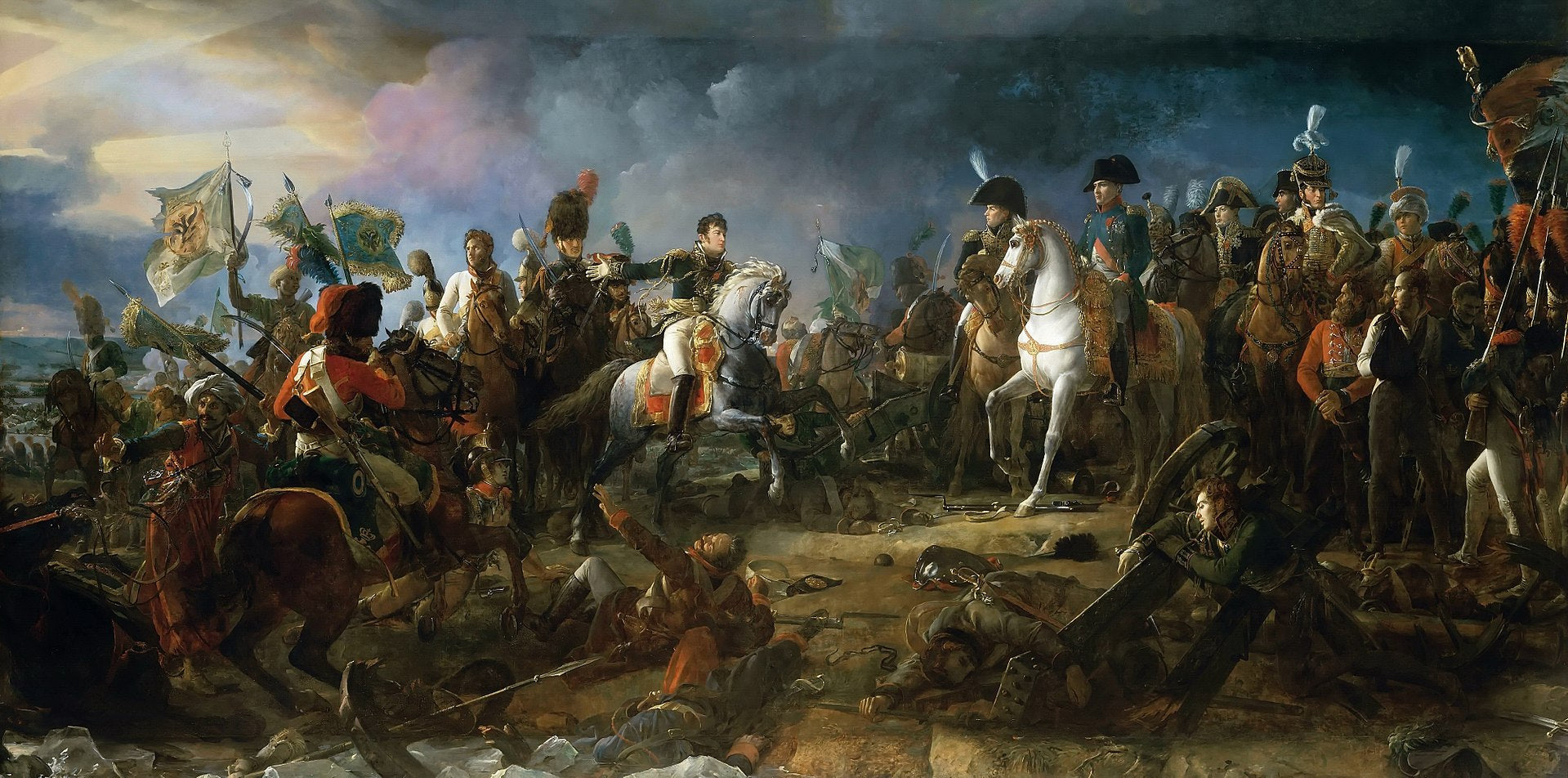War of the Third Coalition (1803-05)
The ‘Definitive Treaty of Peace’ concluded at Amiens proved anything but. Britain was not reconciled to French hegemony in Europe and feared that Napoleon would further expand French influence in Europe with the creation of new satellite states. In May 1803, Britain pre-emptively declared war on France. The following year Pitt returned as Prime Minister and sought new allies on the continent. Napoleon’s coronation as Emperor in November 1804 angered the Holy Roman Emperor (Francis II) and the Emperor of Russia (Alexander I), neither of whom would allow a ‘Corsican upstart’ such as Bonaparte to enjoy a similar dignity to theirs. In 1805 Russia and Austria would join Britain to form the Third Coalition.
The Third Coalition allies planned to attack Napoleon from a number of directions, with (Anglo-Russian) amphibious landings in Naples, together with (Austro-Russian) land campaigns in northern Italy and southern Germany. Napoleon had initially intended to invade Britain and had trained the Army of England on France’s Atlantic coast for this purpose. The British Royal Navy was dominant at sea, but Napoleon knew that if he could control the English Channel for a day, he could make the crossing with his men and conquer Britain with ease.
He ordered his Admiral Pierre-Charles Villeneuve to sail to the West Indies before making a dash for the Channel. Sailing east from the West Indies, the cautious Villeneuve received false intelligence that a British fleet was awaiting him in the Channel and instead sailed to the Spanish port of Cadiz to join his Spanish allies. Frustrated, by the end of August Napoleon marched his army, now renamed the Grande Armée (Great Army), eastwards to confront the Austrian and Russian forces gathering in central Europe. When Villeneuve finally attempted to break out of his blockade at Cadiz with his Spanish allies, the Royal Navy won a decisive victory at Trafalgar on 21 October 1805. The British were victorious, but their brilliant naval commander Lord Nelson had been killed in the moment of his greatest victory.
By the time Villeneuve was defeated at Trafalgar, Napoleon had already secured one of the most brilliant strategic successes of his career. He had divided his army into several Corps, each under the command of a trusted Marshal of the Empire. These units took different routes to the same destination, enabling the army to travel a lot quicker. By September Napoleon’s men were already in southern Germany. Napoleon set his sights on Austrian General Karl Mack’s army of 40,000 stationed in the Bavarian city of Ulm. In early October Mack was surprised to find the French already at his rear and attempted to break out. While some of the Austrians did manage to escape, Ulm was completely surrounded by 16 October. Three days later, 25,000 of Mack’s men surrendered to Napoleon, their commander presenting himself to the conqueror as “the unfortunate General Mack.” Some further Austrian units were duly neutralised in turn. Napoleon had eliminated an entire Austrian army without fighting a major battle. A month later Napoleon was in Vienna, after the Austrian force defending the city mistakenly believed that an armistice had been signed.
The Russian commander Mikhail Kutuzov had been marching his army to join Mack, but once he heard of the Austrian’s capitulation he decided to retreat to the east in order to unite with a second Russian army under General Fyodor Buxhoeweden. The two Russian armies joined up at Brünn (Brno, Czechia) and marched southeast to meet Napoleon on 1 December. Napoleon’s men occupied the high ground of the Pratzen Heights, a gently sloping hill in the middle of the battlefield, and he was confident of securing a conventional victory. However, he had more ambitious plans and evacuated the heights, which were soon occupied by the Russians. The two armies were deployed on a north-south axis, with the French facing eastwards.
The Battle of Austerlitz, one of the most famous of the Napoleonic age, commenced on the morning of 2 December. Napoleon had deliberately left his right (southern) flank weak and the allies duly fell into his trap by committing their forces to this sector and leaving their centre – anchored on the Pratzen Heights – exposed. At around 9 in the morning, the sun rose and burned away the mist which had previously shrouded General Soult’s Corps of 16,000 men advancing on the heights. The Russians occupying the heights were shocked by the large mass of men advancing against them and desperately tried to organise a defence. It was too late. The allies had extended too far on their left and despite fighting bravely, their formation was broken and Napoleon secured the decisive victory he desired. Defeat at Austerlitz forced the Austrians to come to terms with the Treaty of Pressburg (Bratislava), ending the Third Coalition. The following year, Emperor Francis II, fearing Napoleon’s increasing influence in Germany could make him a challenger for the imperial throne, dissolved the Holy Roman Empire and became Emperor Francis I of Austria.
War of the Fourth Coalition (1806-07)
Despite entreaties from Russia and Austria to join the Third Coalition, the Kingdom of Prussia opted to remain neutral. They would soon rue the decision as it soon became clear that Napoleon was intent on expanding his influence beyond the Rhine, encroaching on Prussian territory. In August 1806, Prussia pre-emptively declared war on France, joining Britain and Russia in the Fourth Coalition. The Prussian army was commanded by the Duke of Brunswick, with Prince Hohenlohe as second in command. Each man led an army of around 70,000 men. Napoleon was surprised by the Prussian advance but countered with his own in early October. On 14 October, Napoleon managed to secure a comfortable victory over the enemy at Jena. He was under the impression that he was facing the main Prussian force under Brunswick, but he had in fact been fighting Hohenlohe’s smaller force. Only by the end of the day did he learn with great surprised that Marshal Davout’s Corps of 26,000 men had defeated Brunswick’s army of 65,000. While Davout had been on the defensive, his men had defended tenaciously and Brunswick was killed in the midst of the fighting. The loss of their commander demoralised the Prussian army which soon fell into disorder. Over the course of a single day, the reputation of the Prussian military machine had been completely shattered.
The victories at Jena and Auerstedt became another definitive moment of the Napoleonic age. The remnants of the Prussian army fled back to Berlin. King Frederick William III decided to fight on and join his Russian allies, abandoning Berlin to Napoleon. While in the Prussian capital, Napoleon issued the Berlin Decree on 21 November, establishing the Continental System which blockaded continental ports to British commerce. Napoleon knew he could not hope to defeat the Royal Navy, and decided his best chance of victory over Britain was to cripple her economy by restricting her trade with Europe. (Some 200 years later, the British would attempt to accomplish this through their own volition.) Napoleon marched further east before making his winter camp in Poland.
On 7-8 February 1806 Napoleon met the Russians at Eylau (Bagrationovsk, Kaliningrad Oblast, Russia) where he met stiff resistance from the Russians in the form of General Levin August Bennigsen’s 60,000 man army. The battle was one of the bloodiest of the Napoleonic era and ended inconclusively, with both sides declaring victory. Although Bennigsen had to retreat his flanks, he maintained a strong position anchored on the town. Following the end of the battle the Russians decided to retreat, but the French also were too exhausted to pursue. Although unable to secure a decisive victory at Eylau, after several months of manoeuvring Napoleon finally achieved his desired victory over Bennigsen at Friedland on 14 June, where the Russians were lured into attacking Jean Lannes’ corps which was soon supported by Napoleon’s main army.
While some of the Russians wanted to fight on, Tsar Alexander decided to come to terms with Napoleon. The two sovereigns met on a raft near Tilsit on the River Niemen. The two men took a liking to each other. Alexander is said to have greeted Napoleon by saying ‘I despise the British as much as you do.’ The remark prompted Napoleon to reply that if that were true, then the two sides could come to terms easily. Russia suffered minimal territorial losses but was asked to join the Continental System. Napoleon also offered French support in Russia’s ongoing war with the Ottoman Empire. Alexander’s Prussian ally was not so lucky. Even the protestations of Queen Louise of Prussia, regarded as the most beautiful woman in Europe, could not prevent Napoleon from depriving Prussia of half its territory. Napoleon transformed the Prussian portion of Poland into the Grand Duchy of Warsaw, which became a French protectorate. Napoleon was now master of almost the entire European continent, with only Portugal and Sweden outside the Continental System.
War of the Fifth Coalition (1809)
Having defeated Austria, Prussia and Russia in quick succession, Napoleon sought to consolidate his control over Europe by bringing Portugal and Sweden into the Continental System and thereby institute a total continental blockade of British commerce. In late 1807 he sent an army to invade Portugal, before consolidating his control in Spain the following year. He achieved this taking advantage of political turmoil in Spain by inviting the two rival kings – Charles IV and his son Ferdinand VII – to a conference in Bayonne, a French town close to the Spanish border. Under the pretext of French arbitration, Napoleon duly imprisoned both men and declared that henceforth his brother Joseph would become King of Spain. This was a mistake. To Catholic Spain, Napoleon was not only a foreigner but an atheist. A Spanish uprising on 2 May 1808 initiated a struggle that would last for six long years in the form of the Peninsular War, with the Spanish and Portuguese, ably supported by their British allies, a constant thorn in Napoleon’s side.
While Napoleon was campaigning in Spain, rumours reached him that the Austrians were preparing for war again. Bear in mind that the Austrians had already been defeated three times by Napoleon and suffered considerable territorial losses on each occasion, yet there they were once again, like the black knight in Monty Python and the Holy Grail, eager to renew battle despite missing three limbs. Napoleon returned to France, dispatching his long-time Chief of Staff, Louis-Alexandre Berthier, to organise an army to take on a potential Austrian threat. In the years following the debacle at Austerlitz, the Archduke Charles of Austria instituted reforms to the army inspired by Napoleon’s system – allowing for greater mobility and flexibility on the field, while ensuring that officers were equipped with the latest understanding of strategy and tactics. These reforms were not yet complete when Austria decided to go to war in February 1809, initiating the War of the Fifth Coalition (with Britain as Austria’s major ally).
The French were caught by surprise and the Austrians won early victories in Bavaria against Berthier, commanding the army in Germany while Napoleon made his way from Paris. Napoleon’s arrival stabilised the French strategic position and he successfully expelled the Austrians from Bavaria before marching on the imperial capital of Vienna. By May 1809, French forces once again occupied Vienna for the second time in less than four years. The campaign was far from over as the Austrian army under Archduke Charles remained very much intact. On 21-22 May Napoleon attempted to cross the Danube near the villages of Aspern and Essling to the northeast of Vienna. During the ensuing battle the momentum shifted several times, but the battle was eventually decided in the Austrians’ favour when Napoleon decided to retreat. The Battle of Aspern-Essling was Napoleon’s first defeat in over a decade. Even worse for Napoleon, Marshal Jean Lannes – one of his most talented generals and a close personal friend – had been killed by an enemy cannonball.
The Austrians failed to capitalise on their victory and allowed Napoleon the time to strengthen his position. By the end of June he crossed the Danube once again – this time with a much larger force of over 150,000 – and met the Austrians at Wagram, a short distance to the north east of Aspern and Essling. Once again, the Austrian army fought well and gained the upper hand when Marshal Bernadotte disobeyed orders and withdrew his corps in disarray under heavy fire. Napoleon desperately sought to plug the gap with reserves while organising a heavy artillery bombardment of the Austrian position. The artillery had the intended effect, tearing the Austrians to pieces and snatching victory from the jaws of defeat. The Battle of Wagram had taken a heavy toll with both sides suffering more than 25,000 casualties, one of the bloodiest battles of the Napoleonic age. While Charles was not completely defeated and desired to fight on, the Austrian court lost hope and sued for peace. The ensuing Treaty of Schonbrünn signed in 1810 deprived Austria of its Adriatic coast. It was the fourth time the Austrians had been defeated by Napoleon. It would also be the last.
Did you enjoy reading about Napoleon's most glorious campaigns? Check out our collection of products inspired by Napoleon and the First French Empire.


This article is part of a three part series on the seven anti-French coalitions. Here are the other parts:



Share and get 15% off!
Simply share this product on one of the following social networks and you will unlock 15% off!